Hatshepsut › The Queen of the Night » Origins and History
Articles and Definitions › Contents
- Hatshepsut › Who Was
- The Queen of the Night › Antique Origins
Ancient civilizations › Historical places, and their characters
Hatshepsut › Who Was
Definition and Origins
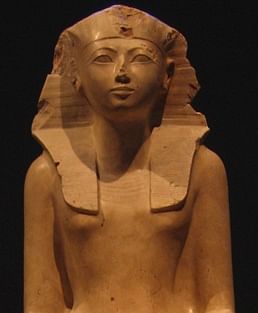
Hatshepsut (1479-1458 BCE) was the first female ruler of ancient Egypt to reign as a male with the full authority of pharaoh.Her name means "Foremost of Noble Women" or "She is First Among Noble Women". She began her reign as regent to her stepson Thuthmose III (1458-1425 BCE) who would succeed her and, initially, ruled as a woman as depicted in statuary. In around the seventh year of her reign, however, she chose to be depicted as a male pharaoh in statuary and reliefs though still referring to herself as female in her inscriptions. She was the fifth pharaoh of the 18th Dynasty during the period known as the New Kingdom (1570-1069 BCE) and regarded as one of the best.
Although she is sometimes cited as the first female ruler of Egypt, or the only one, there were women who reigned before her such as Merneith (c. 3000 BCE) in the Early Dynastic Period (probably as regent) and Sobeknefru (c. 1807-1802 BCE) in the Middle Kingdom and Twosret (1191-1190 BCE) after her toward the end of the 19th Dynasty. Hatshepsut, though not the first or last, is undoubtedly the best known female ruler of ancient Egypt after Cleopatra VII (c. 69-30 BCE) and one of the most successful monarchs in Egyptian history.
Historian Marc van de Mieroop expresses the conventional view of Hatshepsut when he notes how she "has become one of the most celebrated and controversial women of Egypt and the ancient world in general" (172). She is celebrated as a powerful female ruler whose reign was extremely successful and this is the same reason for the controversy: according to Egyptian tradition, no woman should have been able to assume the full power of pharaoh.
HATSHEPSUT "HAS BECOME ONE OF THE MOST CELEBRATED & CONTROVERSIAL WOMEN OF EGYPT & THE ANCIENT WORLD IN GENERAL" (VAN DE MIEROOP)
Further, her name was erased from her monuments following her death which strongly suggests that someone, most likely Thutmose III, wanted to remove all evidence of her from history. Later scribes never mention her and her many temples and monuments were often claimed to be the works of later pharaohs. Her existence only came to light fairly recently in history when the orientalist Jean-Francois Champollion (1790-1832 CE), most famous for deciphering the Rosetta Stone, found he could not reconcile hieroglyphics indicating a female ruler with statuary obviously depicting a male. These hieroglyphics were found in the inner chambers of Hatshepsut's temple at Deir el-Bahri; all public recognition of her had been erased.
Since the Egyptians believed that erasing one's name from history hampered one's afterlife, it is believed that whoever removed her from public knowledge did not wish her ill after death and so preserved her name in more secluded areas. It has also been suggested that her name was simply overlooked in some places out of the public eye. Hatshepsut's building projects were numerous, after all, and it is certainly possible that those responsible for blotting her name out simply missed some.Efforts to erase Hatshepsut from memory were ultimately unsuccessful, however, as she is well known today as one of the greatest pharaohs of ancient Egypt.
EARLY LIFE & RISE TO POWER
Hatshepsut was the daughter of Thuthmose I (1520-1492 BCE) by his Great Wife Ahmose. Thutmose I also fathered Thutmose II by his secondary wife Mutnofret. In keeping with Egyptian royal tradition, Thutmose II was married to Hatshepsut at some point before she was 20 years old. During this same time, Hatshepsut was elevated to the position of God's Wife of Amun, the highest honor a woman could attain in Egypt after the position of queen and, actually, bestowing far more power than most queens ever knew.
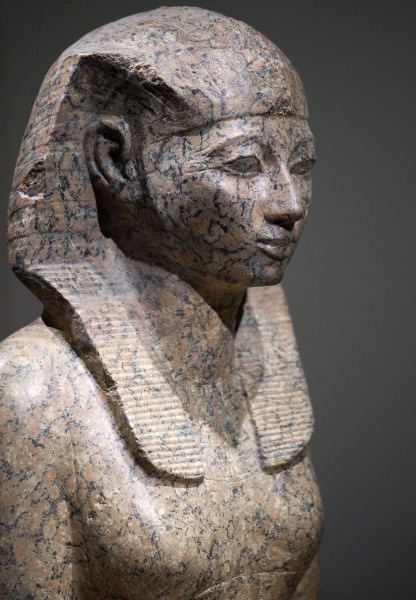
Portrait of Queen Hatshepsut
The position of God's Wife of Amun at Thebes began as an honorary title for a woman of the upper class who assisted the high priest in his duties at the Great Temple of Amun at Karnak. The title is first mentioned in the Middle Kingdom (2040-1782 BCE) as an honorific bestowed on a king's wife or daughter. By the time of the New Kingdom, however, a woman holding the title of God's Wife of Amun was powerful enough to dictate policy (though not as powerful as she would become later in the Third Intermediate Period ). Amun was the most popular god at Thebes and, in time, came to be seen as the creator god and king of the gods. In her role as this god's wife, Hatshepsut would have been considered his consort and would have presided over his festivals. This would have essentially elevated her to the status of a divine being in that it would have been her role to sing and dance for the god at the beginning of festivals to arouse him for the creative act; by engaging directly with the god, she would have taken on an elevated status. The details of exact duties of the God's Wife of Amun are unclear but it is certain that it was a very powerful office which would only become more so later in Egypt's history.
Hatshepsut and Thutmose II had a daughter, Neferu-Ra, while Thutmose II fathered a son with his lesser wife Isis. This son was Thutmose III who was named his father's successor. Thutmose II died while Thutmose III was still a child and so Hatshepsut became regent, controlling the affairs of state until he came of age. In the seventh year of her regency, though, she changed the rules and had herself crowned pharaoh of Egypt. She took on all the royal titles and names which she had inscribed using the feminine grammatical form but had herself depicted as a male pharaoh. Van de Mieroop writes:
Whereas she had been represented as a woman in earlier statues and relief sculptures, after her coronation as king she appeared with male dress and gradually became represented with male physique. Her breasts did not show and she stood in a traditional man's posture rather than a woman's. Some reliefs were even re-carved to adjust her representation to appear more like a man (172).
Her statuary showed her in all her royal grandeur in the forefront with Thutmose III rendered on a smaller scale behind or below her to indicate his lower status. She still referred to her stepson as the king but he was so in name only. Hatshepsut clearly felt she had as much right to rule Egypt as any man and her depiction in art stressed this. Historians Bob Brier and Hoyt Hobbs comment on this:
Her male garb was not intended to fool the citizens into believing their pharaoh was male. Statues unequivocally portray a female, whose sex, in any case, would have been obvious to any Egyptian from her name, "She is First Among Noble Women". Rather than denying her femininity, she was proclaiming that she was also a pharaoh, an office that traditionally had been held by a man (30).
Recognizing that she was in uncharted waters, Hatshepsut took steps to legitimize her reign quickly. If her position as pharaoh were to be challenged, she was not going to allow herself to simply disappear.
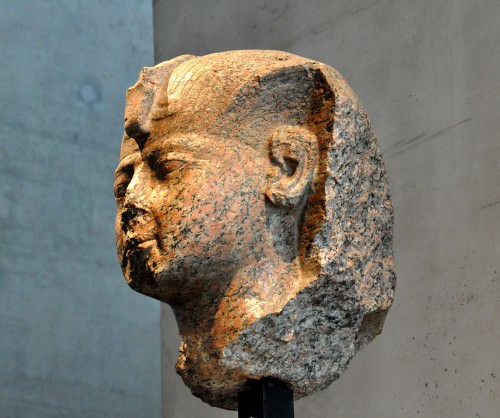
Head of Hatshepsut
THE EARLY REIGN OF HATSHEPSUT
Hatshepsut began her reign by marrying her daughter to Thutmose III and bestowing on Neferu-Ra the position of God's Wife of Amun in order to secure her position. Even if she were now forced to relinquish power to Thutmose III she would still be in a strong position as his step-mother and mother-in-law and, further, she had her daughter in one of the most prestigious and powerful positions in the land. These precautions were not enough, however, and she legitimized her reign by presenting herself not merely as Amun's wife in ritual but as his daughter. She claimed that Amun had appeared to her mother in the form of Thutmose I and conceived her, thus making her a demi-goddess. Her inscription relates the night of her conception as her mother lay in bed:
He [Amun] in the incarnation of the Majesty of her husband, the King of Upper and Lower Egypt, [Thutmose I] found her sleeping in the beauty of her palace. She awoke at the divine fragrance and turned towards his Majesty. He went to her immediately, he was aroused by her he imposed his desire upon her. He allowed her to see him in his form of a god and she rejoiced at the sight of his beauty after he had come before her. His love passed into her body. The palace was flooded with divine fragrance (van de Mieroop, 173).
She furthered her legitimacy through reliefs on public buildings showing Thutmose I making her his co-ruler, claiming that Amun had earlier sent an oracle predicting her rise to power, and linking herself to the expulsion of the Hyksos some 80 years before. The Hyksos were a Semitic people who established themselves at Avaris in Lower Egypt and gradually assumed enough power to control the region. They were defeated and driven from Egypt by Ahmose of Thebes (c. 1570-1544 BCE) which initiated the period of the New Kingdom. The later Egyptian historians regularly characterized the Hyksos (referred to as Asiatics) as hated tyrants who invaded Egypt, sacked temples, and desecrated shrines. Even though these claims were all either exaggerations or untruths, the Egyptian memory of the hated Hyksos was strong and Hatshepsut made good use of that. One of her inscriptions reads:
I have restored what was destroyed. I have raised up what had been shattered, since the Asiatics were in the Delta at Avaris, when the nomads among them were overturning what had been made. They ruled without the god Ra and did not act by divine decree right down to my Majaesty's time (van de Mieroop, 145).
IN KEEPING WITH TRADITION, HATSHEPSUT SET ABOUT COMMISSIONING BUILDING PROJECTS, SUCH AS HER TEMPLE AT DEIR EL-BAHRI, & SENDING OUT MILITARY EXPEDITIONS.
She presented herself as a direct successor to Ahmose, whose name the people still remembered as their great liberator, in order to further strengthen her position and defend against detractors who would claim a woman was unfit to rule. Her numerous inscriptions, monuments, and temples all demonstrate how unprecedented her reign was: no woman before her had ruled the country openly as pharaoh.
PHARAOH HATSHEPSUT
In keeping with tradition, Hatshepsut set about commissioning building projects, such as her temple at Deir el-Bahri, and sending out military expeditions. The exact nature of the military campaigns is unclear but their objectives were the regions of Syria and Nubia. It is likely that the campaigns were launched simply to uphold the tradition of pharaoh as a warrior-king bringing wealth into the land through conquest, could have been seen as a continuation of Thutmose I's campaigns in those regions (further legitimizing her position), or could have been fairly provoked. The pharaohs of the New Kingdom, the age of empire, placed great emphasis on keeping secure buffer zones around the country to avoid a repeat of what they saw as the "invasion" of the Hyksos.
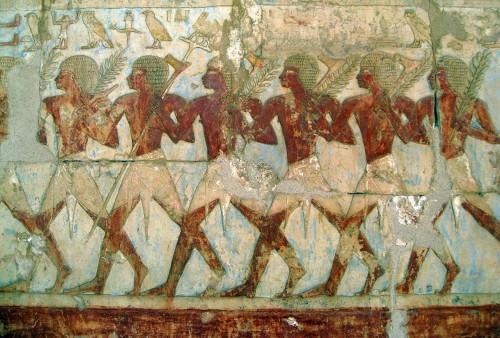
Egyptian Soldiers
In all her projects, campaigns, and policies she relied on the advice and support of one of her courtiers, a man named Senenmut, whose relationship with the queen remains mysterious. Van de Mieroop notes that, "he was a man of undistinguished birth who rose to prominence at court. Several statues show him holding princess Neferu-Ra whose mentor and steward he became before Hatshepsut's accession" (174-175). He was in charge of all of Hatshepsut's grandest projects including her famous temple at Deir el-Bahri.
Hatshepsut's greatest efforts went into these building projects which not only elevated her name and honored the gods but employed the people. The scope and size of Hatshepsut's constructions, as well as their elegant beauty, attest to a very prosperous reign. None of her projects could have been completed as they were if she were not in command of a wealth of resources. Egyptologist Betsy M. Bryan writes:
As ruler, Hatshepsut inaugurated building projects that far out-stripped those of her predecessors. The list of sites touched by Thutmose I and II was expanded in Upper Egypt to include places that the Ahmosid rulers had favoured: Kom Ombo, Nekhen (Hierakonopolis), and Elkab in particular, but also Armant and Elephantine...However, no site received more attention from Hatshepsut than Thebes. The temple of Karnak grew once more under her supervision with the construction work being directed by a number of officials...With the country evidently at peace during most of the twenty years of her reign, Hatshepsut was able to exploit the wealth of Egypt's natural resources, as well as those of Nubia. Gold flowed in from the eastern deserts and the south: the precious stone quarries were in operation, Bebel el-Silsila began to be worked in earnest for sandstone, cedar was imported from the Levant, and ebony came from Africa (by way of Punt, perhaps). In the inscriptions of the queen and her officials, the monuments and the materials used to make them were specifically detailed at some length. Clearly Hatshepsut was pleased with the amount and variety of luxury goods that she could acquire and donate in Amun's honour; so much so that she had a scene carved at Deir el-Bahri to show the quantity of exotic goods brought from Punt (Shaw, 229-231).
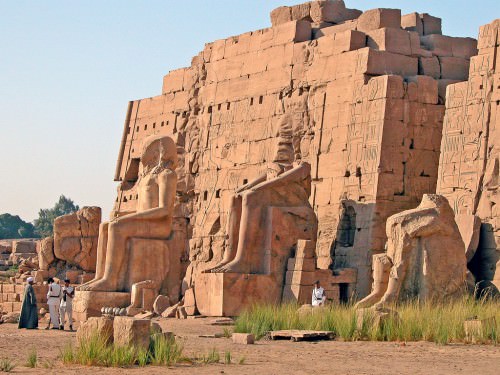
Hatshepsut's Temple, Karnak
Hatshepsut's expedition to Punt (modern day Somalia) was her crowning achievement in her own eyes. Punt had been a partner in trade since the time of the Middle Kingdom but expeditions there were expensive and time-consuming. That Hatshepsut could launch her own expedition, especially one so lavish, is a testament to how prosperous her reign was. The inscription which accompanies the relief of the expedition, engraved on the walls of her temple at Deir el-Bahri, describes the luxury goods in detail:
The loading of the ships very heavily with marvels of the country of Punt; all goodly fragant woods of God's Land, heaps of myrrh-resin, with fresh myrrh trees, with ebony and pure ivory, with green gold of Emu, with cinnamon wood, Khesyt wood, with Ihmut-incense, sonter-incense, eye cosmetic, with apes, monkeys, dogs, and with skins of the southern panther. Never was brought the like of this for any king who has been since the beginning (Lewis, 116).
Her temple at Deir el-Bahri remains one of the most impressive and often visited in Egypt. Brier and Hobbs note how "the art produced under her authority was soft and delicate; and she constructed one of the most elegant temples in Egypt against the cliffs outside the Valley of the Kings" (30). Her temple rose from beside the River Nile with a long ramp ascending from a courtyard of trees and small pools to a terrace. Some of these trees were brought from Punt and are the first known successful transplants of trees from one nation to another in history. The remains of these trees, fossilized tree stumps, can still be seen in the courtyard of the temple in the present day. The lower terrace was lined with columns and a ramp led up to a second terrace which was equally impressive. The temple was decorated with statuary, reliefs, and inscriptions with her burialchamber carved out of the cliffs which form the back of the building. Hatshepsut's temple was so admired by the pharaohs who came after her that they increasingly chose to be buried nearby and this necropolis came to eventually be known as the Valley of the Kings.
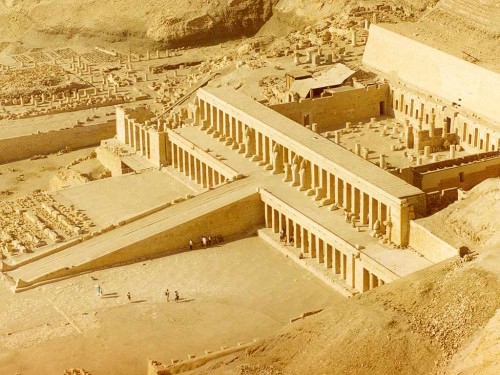
Temple of Hatshepsut
Hatshepsut built on a grander scale than any pharaoh before her and, except for Ramesses II (1279-1213 BCE) none who came after. She had two enormous obelisks raised at Karnak in addition to those elsewhere and, as noted, commissioned building projects throughout the country. So vast were her building projects, in fact, that there are few museums featuring ancient Egyptian art and artifacts in the present day which do not have some piece commissioned by Pharaoh Hatshepsut.
DEATH & DISAPPEARANCE
While Hatshepsut had been ruling the country, Tuthmose III had not been sitting quietly by watching. She gave him command of the armies of Egypt and it has been suggested (most notably by Egyptologist James Henry Breasted) that he survived her reign by proving himself useful to her as a general and, more or less, keeping out of her way.
In c. 1457 BCE Tuthmose III led his armies to put down a rebellion from Kadesh (the famous Battle of Megiddo), a campaign possibly anticipated and commissioned by Hatshepsut, and afterwards her name disappears from the historical record.Thuthmose III back-dated his reign to the death of his father and Hatshepsut's accomplishments as pharaoh were ascribed to him. When and how she died was unknown until recently. Egyptologist Zahi Hawass claimed to have located her mummy in the Cairo museum's holdings in 2006 CE. An examination of that mummy shows that she died in her fifties from an abscess following a tooth extraction.
Tuthmose III went on to become a great pharoah known now as "the Napoleon of Ancient Egypt" for his brilliant military victories. Later in his reign he had all evidence of his step-mother erased from monuments and all evidence of her reign destroyed. Senenmut and Neferu-Ra had both died long before and there was no one at court, it seems, who had the power or inclination to change this policy. The wreckage of some of these works was dumped near her temple at Deir el-Bahri and excavations brought her name to light along with the inscriptions inside the temple which Champollion was so mystified by.Although there have been many theories over the years as to why Tuthmose III tried to blot Hatshepsut's name from history, the most likely reason was that her reign had been unconventional and departed from tradition.
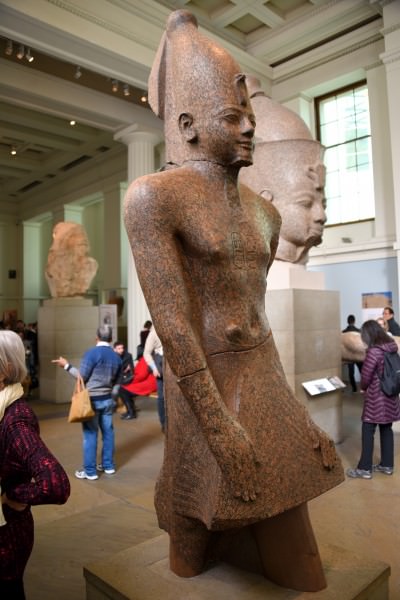
Statue of King Thutmose III
The pharaoh's chief responsibility was the maintenance of ma'at (harmony, balance) and a woman in a man's position would have been seen as disruptive to that balance. The pharaoh served as a role model to his people and it is possible that Tuthmose III feared that other women might look to Hatshepsut for inspiration and try to follow her example, thereby departing from a tradition which maintained that men should rule Egypt and women should be only consorts, as it was in the beginning of time when the god Osiris ruled with his consort Isis. Ancient Egyptian culture was very conservative in many respects and placed no value on change or alteration in tradition. A female pharaoh, no matter how successful her reign, was outside of the accepted understanding of the role of the monarchy and so all memory of that pharaoh had to be erased.
The Egyptian belief that one lives on as long as one's name is remembered, however, is exemplified in Hatshepsut. She was forgotten as the period of the New Kingdom continued and remained so for centuries. Once her name was found again by Champollion in the 19th century CE, and then by others throughout the 20th, she gradually came back to life and assumed her rightful place as one of the greatest pharaohs in Egypt's history.
The Queen of the Night › Antique Origins
Ancient Civilizations
The Queen of the Night (also known as the `Burney Relief') is a high relief terracotta plaque of baked clay, measuring 19.4 inches (49.5 cm) high, 14.5 inches (37 cm) wide, with a thickness of 1.8 inches (4.8 cm) depicting a naked winged woman flanked by owls and standing on the backs of two lions. It originated in southern Mesopotamia (modern day Iraq) most probably in Babylonia, during the reign of Hammurabi (1792-1750 BCE) as it shares qualities in craftsmanship and technique with the famous diorite stele of Hammurabi's laws and also with the piece known as `The god of Ur ' from that same period.
The woman depicted in the relief is acknowledged to be a goddess as she wears the horned headdress of a deity and holds the sacred rod-and-ring symbol in her raised hands. Not only is the woman winged but her legs taper to bird talons (which seem to grip the lion's backs) and she is shown with a dew claw on her calves. Along the base of the plaque runs a motif which represents mountains, indicating high ground. Who the winged woman is, however, has not been agreed upon though scholars generally believe her to be either Inanna ( Ishtar ), Lilith, or Ereshkigal. The piece is presently part of the collection of the British Museum, Room 56, in London.
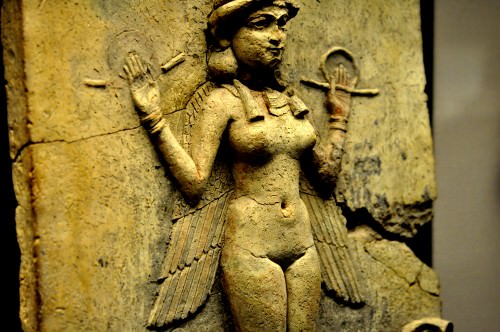
The Queen of The Night Relief
THE BURNEY RELIEF'S HISTORY
In 1936 CE the Burney Relief was featured in the Illustrated London News highlighting the collection of one Sydney Burney who purchased the plaque after the British Museum passed on the offer to buy it. Since the piece was not archaeologically excavated, but rather simply removed from Iraq sometime between the 1920's and 1930's CE, its origin and context are unknown. How the plaque arrived in London is also unknown, but it was in the possession of a Syrian antiquities dealer before coming to the attention of Sydney Burney.
Not much is known of Sydney Burney other than that he was a Captain in the English Army during WWI and was President of the Antique Dealers Association in London. The plaque was broken in three pieces and some fragments when originally purchased but, once repaired, was found to be mostly intact. The Burney Relief was analyzed in 1933 and authenticated in 1935 CE prior to the offer made to the British Museum. The plaque then changed hands twice before the British Museum finally acquired it in 2003 CE for the sum of 1,500,000 pounds, a considerably higher price than what was asked in 1935. It was at this time that the piece known as the Burney Relief came to be called `The Queen of the Night' due to the dark black pigment of the plaque's original background and the iconography (the downward pointing wings, the talon feet etc.) associating the female figure with the underworld. The name is therefore a modern, not an ancient, designation for the plaque. There is no way to know what the piece was originally called or what purpose it was created for.
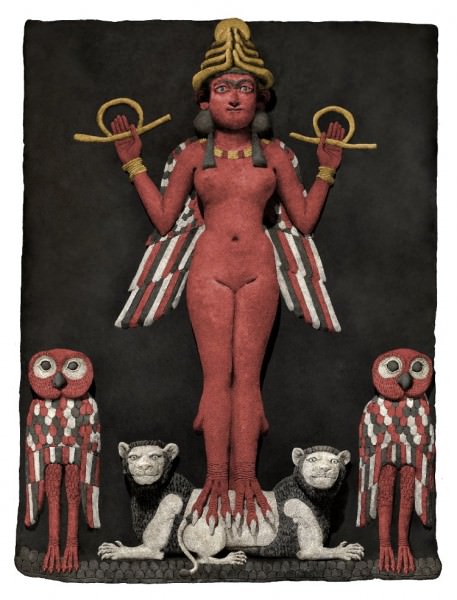
The Queen of the Night Reconstruction
THE COMPOSITION OF THE RELIEF
The relief was made of clay with chaff added to bind the material and prevent cracking. The fact that the piece was fired in an oven, and not sun dried, testifies to its importance as only the most significant works of art and architecture were created in this way. Since timber was scarce in southern Mesopotamia, it was not used lightly for firing clay objects. According to Dr. Dominique Collon of the British Museum the plaque was made by
...clay pressed into a mould and allowed to dry in the sun…the figure was made from fairly stiff clay which was folded and pushed into a specially shaped mould, with more clay added and pressed in behind to form the plaque. Thus the Queen's figure is an integral part of the plaque and was not added to it later. After drying, the plaque was removed from the mould, the details were carved into the leather-hard clay and the surface was smoothed. This smoothed surface is still visible in certain places, notably near the Queen's navel…The edges of the plaque were trimmed with a knife. Then the plaque was baked. (15)
Once the piece was done baking and had cooled, it was painted with a black background, the woman and the owls in red, and lions in white with black manes. The rod-and-ring symbols, the woman's necklace, and her headdress were gold. The original color traces may still be detected on the piece today even though they have largely worn away over the centuries.
ORIGINS & PLACEMENT
While it may never be known exactly where the piece was made, for what purpose, or which goddess it represents, the similarities in technique between it and the so-called `God of Ur', are so striking that it has been speculated that the Sumerian city of Ur is its place of origin. Dr. Collon notes:
The god from Ur is so close the Queen of the Night in quality, workmanship and iconographical details that it could well have come from the same workshop, perhaps at Ur, where extensive remains of the Old Babylonian period were excavated between 1922 and 1934. (20)
The individual who originally removed the plaque, then, could have been a member of one of the excavating teams during that time or simply someone who came upon the piece once it was uncovered.
Theories as to its original placement and significance have been suggested by every scholar who has studied it. As sacred prostitution was practiced throughout Mesopotamia, the historian Thorkild Jacobsen believed that the plaque formed a part of a shrine in a brothel. Dr. Collon notes, however, that “if this were so, it must have been a very high-class establishment, as demonstrated by the exceptional quality of the piece” (22). She further theorizes that the plaque would have been hung on a wall of mud brick, probably in an enclosure, and that, when the mud brick wall collapsed, the fired terracotta plaque would have remained relatively intact. The fact that the piece has survived for over 3000 years attests to its having been buried fairly early after the building which housed it fell or was abandoned because it was thereby protected from the elements and from vandalism.
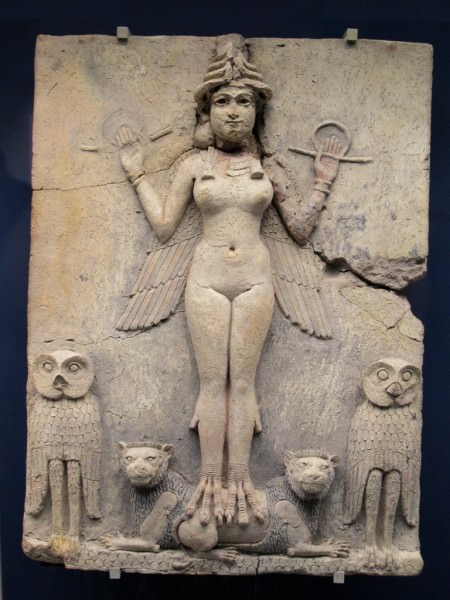
Queen of the Night
THE IDENTITY OF THE QUEEN OF THE NIGHT
The identity of the Queen is the most intriguing aspect of the piece and, as noted above, three candidates have been proposed: Inanna, Lilith, and Ereshkigal. The nude woman motif was popular throughout Mesopotamia. The historian Jeremy Black notes:
Hand-made clay figurines of nude females appear in Mesopotamia in prehistoric times; they have applied and painted features. Figurines of nude women impressed from a pottery or stone mould first appear at the beginning of the second millennium BC…It is very unlikely that they represent a universal mother goddess, although they may have been intended to promote fertility. (144)
Inanna would be the goddess in keeping with a plaque encouraging fertility as she presided over love and sex (and also war ) but there are a number of problems with this identification.
Inanna
If one accepts the findings of Dr. Black and others who agree with him, then that poses a problem with Inanna as Queen of the Night since she was not universally regarded as a mother goddess in the way that Ninhursag (also known as Ninhursaga) was. Ninhursag was the mother of the gods and was regarded by the people as the great mother goddess. There are also problems with Inanna as the Queen stemming from the iconography of the piece. While Inanna is associated with lions, she is not linked with owls. The headdress and the rod-and-ring symbols would fit with Inanna, as would the necklace, but not the wings or the talon-feet and dew claw. The scholar Thorkild Jacobsen, arguing for Inanna as the Queen, presents four aspects of the plaque which point to the Queen's identity:
- Lions are an attribute of Inanna.
- The mountains beneath the lions are a reflection of the fact that Inanna' s original home was on the mountaintops to the east of Mesopotamia.
- Inanna took the rod-and-ring with her in her descent to the underworld and her necklace identified her as a harlot.
- Her wings, bird talons and owls show that Inanna is pictured in her aspect of Owl goddess and goddess of harlots.
Dr. Collon, however, dismisses these claims pointing out that Inanna “is associated with one lion, not two” and the point regarding the rod-and-ring symbol and necklace can be discounted as they “could have been worn or held by any goddess” (42). Dr. Collon also points out that the “first published photograph of the Queen of the Night relief in 1936 read: `Ishtar…the Sumerian goddess of love, whose supporting owls present a problem'” (43). Ishtar was the later name for Inanna and, while owls have been mentioned in tales concerning the goddess, they were never a part of her iconography. Further, Inanna is never depicted frontally in any ancient art but, always, in profile and the mountain range at the bottom of the plaque could argue as well for identification with Ereshkigal or Lilith.
Lilith
Lilith is a demon, not a goddess, and although there is some association of the Lilith demon with owls, they are not the same kind of owls that appear on the relief. Further, Lilith comes from the Hebrew tradition, not the Mesopotamian, and corresponds only to the Mesopotamian female demons known as lilitu. The lilitu and the so-called ardat lili demons were especially dangerous to men whom they would seduce and destroy. The male demons of this sort, the lilu, preyed on women and were an especial threat to those who were pregnant or had just given birth and also to infants. The article, The Burney Relief: Inanna, Ishtar, or Lilith? states why the Lilith identification is a probability:
Rafael Patai (The Hebrew Goddess 3rd ed. 1990) relates that in the Sumerian poem Gilgamesh and the Huluppu Tree, a she-demon named Lilith built her house in the Huluppu tree on the banks of the Euphrates before being routed by Gilgamesh. Patai then describes the Burney plaque: “A Babylonian terra-cotta relief, roughly contemporary with the above poem, shows in what form Lilith was believed to appear to human eyes.She is slender, well-shaped, beautiful and nude, with wings and owl-feet. She stands erect on two reclining lions which are turned away from each other and are flanked by owls. On her head she wears a cap embellished by several pairs of horns. In her hands she holds a ring and rod combination. Evidently this is no longer a lowly she-demon, but a goddess who tames wild beasts and, as shown by the owls on the reliefs, rules by night.
Even so, the possibility that the Queen of the Night plaque, with its high degree of skill in craftsmanship and attention to detail would be a representation of a lilitu is highly unlikely. According to the Hebrew tradition, Lilith was the first woman made by God who refused to submit to Adam's sexual demands and flew away, thus rebelling against God and his plans for human beings. She was thought to have then occupied the wastelands and, like the lilitu, to have preyed on unsuspecting men ever since. In either tradition, the lilitu was not a popular enough figure to have been portrayed on a plaque such as the Queen of the Night. Dr. Black notes, “Evil gods and demons are only very rarely depicted in art, perhaps because it was thought that their images might endanger people” (62). The mountain range depicted at the bottom of the relief is also thought to suggest lilitu identification in representing the wilderness the spirit inhabits but the headdress, the necklace, the rod-and-ring symbols and the significance of the plaque all go to argue against Lilith as a possibility.
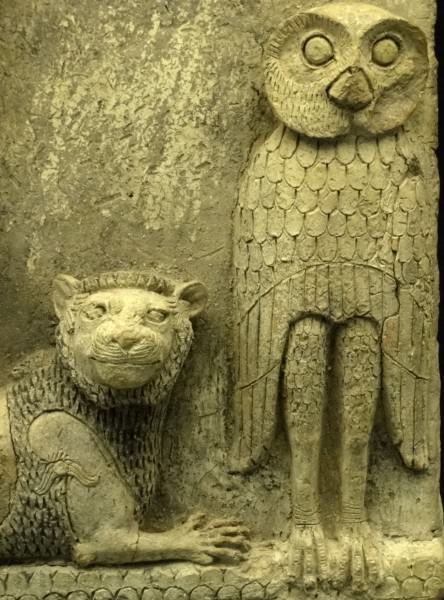
Queen of the Night Detail
Ereshkigal
The third contender is Inanna's older sister, Ereshkigal, the Queen of the Great Below. Her name means “Lady of the Great Place” referring to the land of the dead and there are a number of aspects of the plaque which seem to suggest Ereshkigal as the best candidate for Queen. The motif of the downward pointing wings was used throughout Mesopotamia to indicate a deity or spirit-being associated with the underworld and the Queen has such wings. Ereshkigal lived in the underworld palace of Ganzir, thought to be located in the eastern mountains, which would account for the mountain range depicted running along the bottom of the plaque. Regarding Ganzir and the underworld, Dr. Collon writes, “It was a dark place and the dead, naked or clothed with wings like birds, wandered with nothing to drink and only dust to eat. Whatever they had achieved in life, the only sentence was death, pronounced by Ereshkigal” (44).
Ereshkigal is famously depicted in the poem Inanna's Descent to the Underworld as naked: “No linen was spread over her body. Her breasts were uncovered. Her hair swirled around her head like leeks” (Wolkstein and Kramer, 65) and the Queen on the plaque is nude. Further, unlike depictions of Inanna in profile, the Queen is shown from the front. Dr. Collon writes:
As a goddess, Ereshkigal was entitled to the horned headdress and the rod-and-ring symbol. Her frontality is static and immutable and, as Queen of the Underworld where `fates were determined', hers was the ultimate judgment: she might well have been entitled to two rod-and-ring symbols. (44)
In this same way the lions the Queen stands on could represent Ereshkigal' s supremacy over even the mightiest of living things and the owls, with their association with darkness, could be linked to the land of the dead. All of the iconography of the Queen of the Night plaque seems to indicate the deity represented is Ereshkigal but, as Dr. Collon states, “no definite connection with Ereshkigal can be made as she has no known iconography: her association with death made her an unpopular subject” (45). With no known iconography of Ereshkigal to compare the Queen of the Night with, the identity of the Queen remains a mystery.
LICENSE:
Article based on information obtained from these sources:with permission from the Website Ancient History Encyclopedia
Content is available under License Creative Commons: Attribution-NonCommercial-ShareAlike 3.0 Unported. CC-BY-NC-SA License